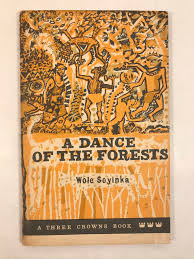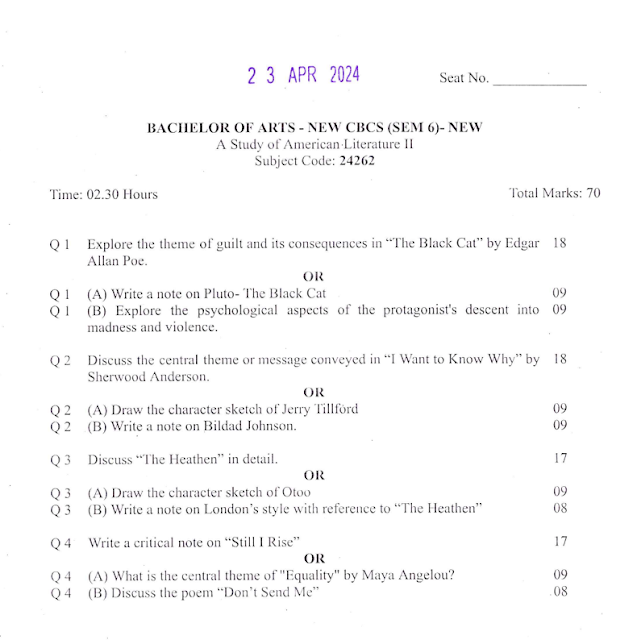'A Dance of the Forests' by Wole Soyinka
Key points about Wole Soyinka:
- Wole Soyinka is a Nigerian writer, playwright, poet, and political activist. He was born in 1934 in Abeokuta, Nigeria.
- He is regarded as one of the foremost figures in modern African literature. In 1986, he became the first African to be awarded the Nobel Prize in Literature.
- His notable works include the plays "Death and the King's Horseman", "The Lion and the Jewel", and the novels "The Interpreters" and "Season of Anomy".
- Many of his writings deal with the tensions and violence involved in the transition from colonial rule to independence in Nigeria and other African nations.
- He was an outspoken critic of many Nigerian military dictatorships and their suppression of human rights. He was imprisoned for 22 months in the 1960s for speaking out against the Nigerian civil war.
- In addition to the Nobel Prize, he has won many other prestigious awards including the Anisfield-Wolf Book Award and the Agatha Christie Award.
- Stylistically, his works blend Western literary traditions with African folkloric storytelling techniques, Yoruba myths, and beliefs.
- He is also a notable political activist who has campaigned for democracy, human rights, and freedom of expression across Africa for decades.
Key points about Wole Soyinka's play "A Dance of the Forests":
- It was written in 1960 and first performed in 1963 to celebrate Nigeria's independence from British colonial rule.
- The play blends Greek tragedy, Yoruba folklore, and a non-linear plot to explore themes of responsibility, ritual, and Nigeria's pre-colonial past.
- The main characters include the Court Historian and Spirit Champers who preside over a ritualistic re-enactment of the past involving Forest Dwellers and other spirit beings.
- It examines the repeated cycle of human violence and cruelty throughout Nigeria's history, from its earliest origins to the colonial era.
- Ritual plays a central role, with the opening ceremony intended to exorcise the evils of the past before Nigeria can move forward as an independent nation.
- The play's non-linear structure, mixing of genres, and dense symbolism make it a complex, unconventional work regarded as Soyinka's first major artistic success.
- Soyinka incorporates Yoruba myths, masques, drumming, dancing, and the Ogun cult into the theatrical production.
- Themes include the continuity between the present and the past, the seductive nature of power and violence, and moral responsibility.
- It has been praised for its poetic language and inventive theatrical style fusing African and European dramatic traditions.
Question: Write a proposed alternative end of the play 'A Dance of the Forest' by Wole Soyinka.
As the ceremonial dance and ritual re-enactment of Nigeria's violent past reaches its climax, the Court Historian and Spirit Champers look on, hoping the exorcism will allow the nation to move forward unburdened. However, the Forest Dwellers and spirit beings do not disperse as expected.
Instead, the Forest Head pulls Demoke, symbol of the vicious cycle of human cruelty, from the sacrificial offerings. Demoke stands defiant, refusing to be subjugated or destroyed so easily. The Forest Head declares that the ills of the past cannot be simply wished away through ritual alone.
The spirits congregate and rather than exorcise Demoke, they begin integrating parts of him into themselves through a transformative dance. They decide Nigeria's future must directly reckon with and incorporate the harsh truths of its past.
As the dance reaches a frenzy, the Forest Dwellers and spirits merge into one composite spirit figure - part human, part nature deity. This new spirit being represents the synthesis of Nigeria's ancient roots and traditions with the unavoidable stains of its colonial subjugation and civil violence.
The Court Historian and Champers look on stunned as this new figure speaks in a multiplicity of voices. It says Nigeria's path forward requires embracing and transforming the whole truth of its history, not rejecting the ugly parts. Only through this can true independence be achieved.
The spirit figure then dissolves, leaving the elaborate masques and ceremonial props strewn about as if awaking from a dream. The Court Historian and Champers are left to ponder if the ritual failed or succeeded in its own twisted way, as the path to Nigeria's future has been forever altered.
Question: Write a note on the play 'A Dance of the Forest' by Wole Soyinka.
'A Dance of the Forests' by Wole Soyinka:
'A Dance of the Forests' by Wole Soyinka is a groundbreaking Nigerian play that amalgamates Yoruba folklore and rituals with elements of Western dramatic tradition. It was first performed in 1963 as part of the celebrations for Nigeria's independence from British colonial rule.
The play's structure deviates significantly from conventional Western plays. Instead of following a three or five-act linear narrative, it uses a non-linear, circular structure that shifts fluidly between the past and present. This structural technique highlights one of the main thematic concerns - the idea that history tragically repeats itself in a cyclical manner if humans fail to learn from past mistakes.
The main themes explored include:
Nigeria's independence struggle and the need to accept responsibility for the nation's violent past instead of solely blaming colonial powers; the complex relationship between tradition and historical events; and the vital role of the artist in holding a mirror to society's ills.
Soyinka employs a brilliant contrast technique at multiple levels - juxtaposing the living and the dead characters, swinging between tragic and comic moments, portraying vibrant folk characters alongside sterile bureaucratic figures. This serves to create dramatic tension and variety.
The language too exhibits a wide range - from vivid poetic verses invoking ancestral spirits to crude insults exchanged by the sharp-tongued folk characters. Each character's speech style is distinct, rooted in their personality and background.
Perhaps the most innovative aspect is Soyinka's incorporation of traditional Yoruba performance arts like ritual ceremonies, masquerades, drumming and dance into the theatrical production. This gives the play a rich, multi-sensory quality that transcends the written text, making it a complete visually and aurally immersive experience for the audience.
In conceptualizing this play, Soyinka drew from both Western canon like the ancient Greek tragedies as well as his profound understanding of Yoruba myths, philosophy and aesthetics. His ambition was to authentically portray the African, specifically Yoruba, worldview on stage using the colonial English language as a creative paradox.
While being a pathbreaking work celebrated for forging a postcolonial theatrical idiom, 'A Dance of the Forests' also attracted criticism for its complex symbolism that bordered on obscurity, especially towards the enigmatic ending. However, Soyinka defended this obliqueness as a conscious artistic choice to set a thought-provoking "riddle" for the audience rather than simplistic spoon-feeding.
Fusion of Traditions:
The play fuses Yoruba folklore, ritual, music, and dance with Western dramatic traditions. Soyinka blends indigenous African elements like Yoruba myths, masquerades, drumming, and dance with aspects of Western theatre.
Non-linear Structure:
It doesn't follow the typical three or five-act structure, using a non-linear storyline shifting between past and present instead. The play's structure is unconventional, moving back and forth in time without a clear linear plot progression.
Themes:
Main themes are Nigerian independence, tradition vs history, and the artist's role in society. The play explores Nigeria's independence struggle, the link between tradition and historical events, and the social responsibility of the artist.
Acceptance of History:
Soyinka suggests Nigerians must accept their own violent history instead of solely blaming colonialism. He argues that Nigerians need to take responsibility for their past injustices rather than putting all blame on colonial powers.
Repetition of History:
Characters doubling up in past/present roles shows how history repeats if humans don't learn. By having characters play dual roles in different eras, Soyinka highlights the cycle of violence repeating across generations.
Contrasts:
The play employs contrasts between living/dead, tragedy/comedy, vibrant/sterile characters. Soyinka uses contrasts in structure, tone, and characterization to create dramatic tension and variety.
Language Variety:
Language ranges from poetic to graphic insults and diverse character speech styles. The play's language is diverse, including poetic verses, vivid insults, and varied speaking styles for different characters.
Sensory Experience:
Incorporation of Yoruba rituals, dance, drumming makes it a rich sensory stage experience. The use of non-verbal Yoruba performance elements like rituals and dance make the play a multi-sensory theatrical work.
Postcolonial Amalgamation:
It amalgamates Western and African dramatic techniques/philosophy using an English medium. Soyinka blends colonial English language with Yoruba folklore/aesthetics to create a unique postcolonial theatrical form.
Critical Reaction:
While groundbreaking, its complex symbolism and obscure ending divided critics. The play's innovative style was praised but its obscure symbolism/ending also attracted criticism from some quarters.
Conclusion:
The play remains a tour de force - a rich tapestry where Soyinka weaves together diverse cultural traditions into a unique theatrical expression that challenges both the colonial literary canon and ancestral traditions to forge an authentic, uncompromising postcolonial voice speaking in a borrowed language. Its ingenious blending of seemingly disparate elements continues to inspire generations of writers and academics exploring the intersections of language, culture and power dynamics.
PPT by Dr.Yesha Bhatt:
(WC: 1502, Images 03, Video 01)





No comments:
Post a Comment